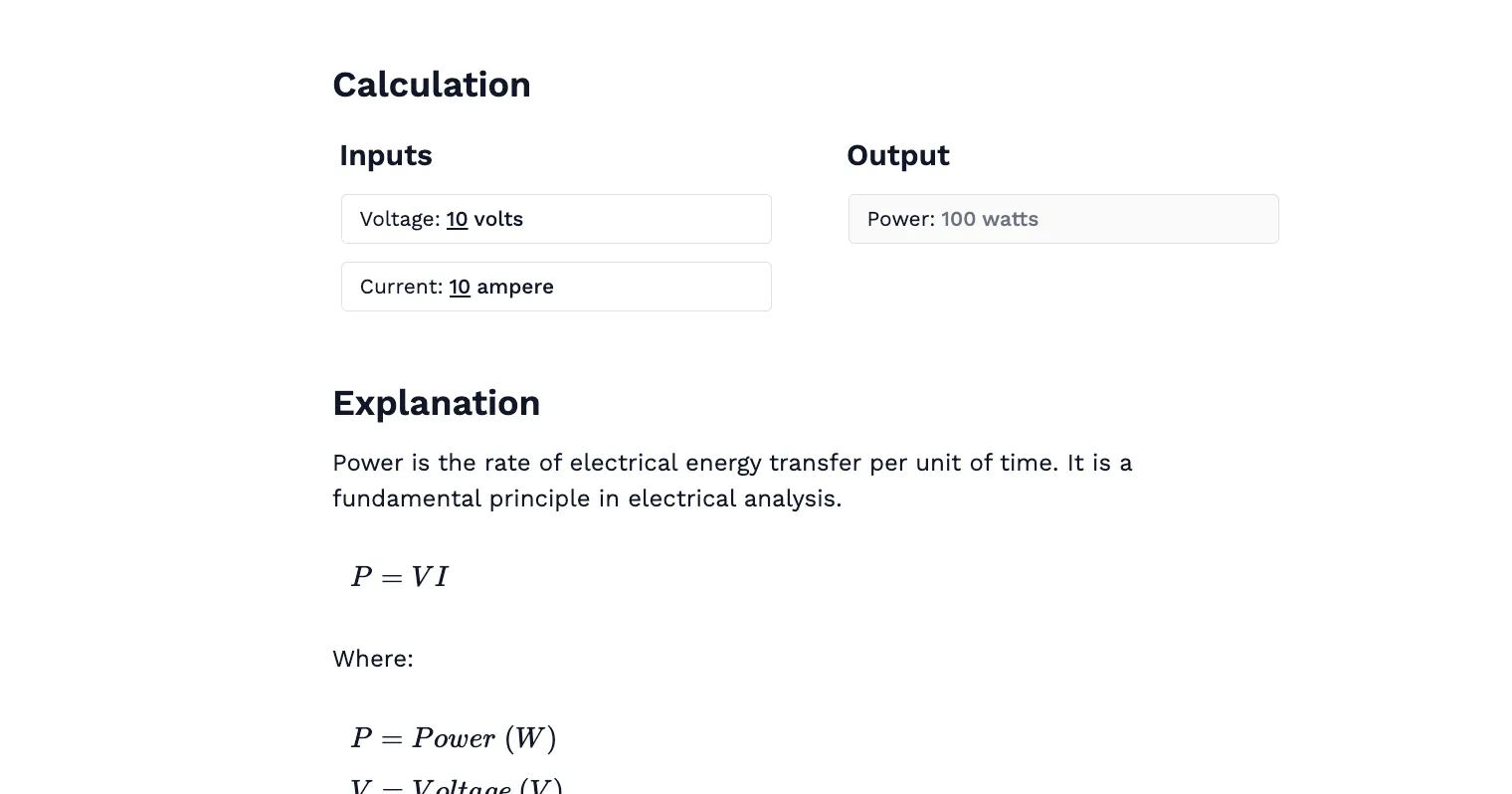Free DC Circuit Power Calculator. Step-by-step, engineering-grade tool with downloadable report.

This template is not available yet. You can sign up and create it yourself!
Or let us know if you'd like to be notified when it’s ready:
About this 'DC Circuit Power Calculator'
The DC Circuit Power Calculator simplifies the process of determining electrical power in direct current (DC) systems. By inputting voltage and current values, users can calculate power (in watts) quickly and accurately. The calculator is intended to assist with electrical design, diagnostics, and education. Enter the values and click 'Calculate' to obtain results such as power in watts, current in amps, and voltage in volts.
This calculator is for:
- Engineers designing or analyzing DC power systems for efficiency and safety
- Technicians performing diagnostics and maintenance on DC circuits
- Students studying circuit theory and learning about power calculations in DC systems
Certain values, such as cable ratings, are selected from standard tables or references to ensure accuracy and safety. The results are displayed on the page, including power in watts, current in amps, and other values derived from your inputs. The calculator provides results for power, current, and other values based on the inputs you provide.
Alternative manual approaches to calculating power involve using standard power formulas and individually measuring voltage and current, which can be more time-consuming and prone to error. The calculator uses these standard formulas to compute results efficiently.
For those looking to expand their knowledge of DC power calculations, “Electrical Engineering: Principles & Applications” by Allan R. Hambley is a great resource that delves into both the theory and practical applications of circuit analysis.
Explore the wide range of resources available and consult additional sources for more in-depth information.
Introduction to DC Circuits
DC circuits, or direct current circuits, form the backbone of many modern electronic devices and systems. In these circuits, electrical current flows in a single, constant direction—from the positive terminal of a power source, such as a battery, through various electrical load like motors or light bulbs, and back to the negative terminal. This unidirectional flow is what distinguishes DC circuits from their AC counterparts. Common applications of DC circuits include smartphones, laptops, and other portable electronics, where stable and reliable power and electrical load is essential.
A DC circuit calculator assists by automating these calculations and offering fast, reliable results that would otherwise be time-consuming if performed manually. For more specific needs, such as determining transformer fault current, try the Transformer Short Circuit Calculator.
Voltage Drop in DC Circuits
Voltage drop is a key consideration in the design and operation of DC circuits. As current travels through a wire or conductor, it encounters wire resistance, which causes a reduction in voltage along the length of the wire. This voltage drop can impact the performance and efficiency of your circuit, especially over long cable runs or when high currents are involved.
To calculate the voltage drop, you can use the formula \(V = I x R\), where \(V\) is the voltage drop, I is the current, and \(R\) is the resistance of the wire. Minimizing voltage drop is crucial for maintaining the desired voltage at the load and ensuring efficient operation. Choosing a wire with low resistance and the appropriate size for your application helps reduce losses. A dc power calculator can assist you in determining the expected voltage drop and selecting the right conductor to ensure your circuit delivers the required power with minimal loss.
DC Circuit Analysis
Analyzing DC circuit involves determining the voltage, current, resistance, and power consumption throughout the system. To perform a thorough analysis, you need to know the values of the voltage source, the resistance of both the wire and the load, and the current flowing through the circuit. By inputting these values into a power calculator, you can quickly determine the total power consumption and identify areas where energy loss may occur.
DC circuit analysis is essential for ensuring that your circuit is capable of handling the required electrical load and operates within safe limits. It also helps you optimize the design to minimize energy loss and improve overall efficiency. Using a calculator streamlines this process, allowing you to make informed decisions about wire size, load capacity, and other critical factors in your circuit.
Troubleshooting DC Circuits
When a DC circuit isn’t performing as expected, troubleshooting is necessary to identify and resolve the issue. Common problems include excessive voltage drop, high current draw, or faulty components. To diagnose these issues, you can use a multimeter to measure voltage, current, and resistance at various points in the circuit. Additionally, a dc power calculator can help you determine the actual power consumption and compare it to expected values.
By systematically analyzing the circuit and using these tools, you can pinpoint the source of the problem—whether it’s a damaged wire, an overloaded component, or an incorrect connection. Taking corrective action based on your findings ensures that the circuit operates efficiently and reliably, minimizing downtime and preventing further issues.
Engineering templates
Common calculators
Design guides
FAQs
What is power dissipation, and why is it important in a DC circuit?
Power dissipation refers to the conversion of electrical energy into heat in circuit components like resistors, which means that part of the supplied energy is lost as heat, reducing circuit performance and potentially impacting safety. The dissipated power is measured in watts. It’s important because excessive dissipation can lead to overheating, damage to components, and can also affect the supply voltage and overall stability of the electrical system.
How do voltage and current affect power in a DC circuit?
The amount of power in a DC circuit is directly proportional to both voltage (\(V\)) and current (\(A\)), which are the primary factors affecting power. Power is measured in units such as watts, while voltage is measured in volts. Resistance (\(R\)), measured in ohms, also plays a key role in determining power dissipation, as power loss increases with higher resistance. In AC circuits, impedance is a related concept that combines resistance and reactance. Additionally, resistance increases with wire length, typically measured in meters, which can further impact voltage drop and power loss in the circuit.
What are common applications of power calculations in DC circuits?
Power calculations are used in designing and optimizing systems such as batteries, solar panels, and other DC-powered devices, and are directly related to ensuring cables and components are not overloaded. Manufacturers provide current ratings for cables to help users select wiring that meets safety and thermal limits, as exceeding these related limits can lead to overheating and safety issues.
Learn about the benefits of using CalcTree on engineering projects!


